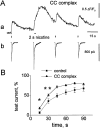Recovery from desensitization of neuronal nicotinic acetylcholine receptors of rat chromaffin cells is modulated by intracellular calcium through distinct second messengers
- PMID: 9502806
- PMCID: PMC6793119
- DOI: 10.1523/JNEUROSCI.18-07-02458.1998
Recovery from desensitization of neuronal nicotinic acetylcholine receptors of rat chromaffin cells is modulated by intracellular calcium through distinct second messengers
Abstract
The mechanisms through which changes in intracellular Ca2+ concentration ([Ca2+]i) might influence desensitization of neuronal nicotinic receptors (nAChRs) of rat chromaffin cells were investigated by simultaneous patch-clamp recording of membrane currents and confocal microscopy imaging of [Ca2+]i induced by nicotine. Increases in [Ca2+]i that were induced by membrane depolarization or occurred spontaneously did not influence inward currents elicited by focally applied test pulses (10 msec) of nicotine, indicating that raised [Ca2+]i per se did not trigger desensitization of nAChRs. Desensitization of nAChRs, evoked by 2 sec focal application of nicotine, which largely raised [Ca2+]i, was not affected by intracellular application of agents that activate or depress protein kinase C (PKC) or A (PKA) or inhibit phosphatase 1, 2 A and B. Conversely, recovery from desensitization was facilitated by the phorbol ester phorbol 12-myristate 13-acetate (PMA) or the phosphatase 2 B inhibiting complex of cyclosporin A-cyclophilin A, whereas it was impaired by the broad spectrum kinase inhibitor staurosporine. The effects of PMA or staurosporine were prevented by the intracellularly applied Ca2+ chelator BAPTA. The adenylate cyclase activator forskolin accelerated recovery, whereas the selective PKA antagonist Rp-cAMPS had an opposite effect. The action of staurosporine and Rp-cAMPS on recovery from desensitization was additive. It is proposed that when nAChRs are desensitized, they become susceptible to modulation by [Ca2+]i via intracellular second messengers such as serine/threonine kinases and calcineurin. Thus, the phosphorylation state of neuronal nAChRs appears to regulate their rate of recovery from desensitization.
Figures





Similar articles
-
Imaging of intracellular calcium during desensitization of nicotinic acetylcholine receptors of rat chromaffin cells.Br J Pharmacol. 1997 Dec;122(7):1323-32. doi: 10.1038/sj.bjp.0701518. Br J Pharmacol. 1997. PMID: 9421278 Free PMC article.
-
Modulation of nicotinic acetylcholine receptor activity in submucous neurons by intracellular messengers.J Auton Nerv Syst. 1999 Jan 15;75(1):16-22. doi: 10.1016/s0165-1838(98)00165-9. J Auton Nerv Syst. 1999. PMID: 9935265
-
Activity-dependent regulation of [Ca2+]i in avian cochlear nucleus neurons: roles of protein kinases A and C and relation to cell death.J Neurophysiol. 1998 May;79(5):2288-302. doi: 10.1152/jn.1998.79.5.2288. J Neurophysiol. 1998. PMID: 9582205
-
Regulation of phospholamban and troponin-I phosphorylation in the intact rat cardiomyocytes by adrenergic and cholinergic stimuli: roles of cyclic nucleotides, calcium, protein kinases and phosphatases and depolarization.Mol Cell Biochem. 1995 Aug-Sep;149-150:103-26. doi: 10.1007/BF01076569. Mol Cell Biochem. 1995. PMID: 8569720 Review.
-
Nicotinic acetylcholine receptors of adrenal chromaffin cells.Acta Physiol (Oxf). 2008 Feb;192(2):203-12. doi: 10.1111/j.1748-1716.2007.01804.x. Epub 2007 Nov 15. Acta Physiol (Oxf). 2008. PMID: 18005395 Review.
Cited by
-
Kinetics of desensitization and recovery from desensitization for human alpha4beta2-nicotinic acetylcholine receptors stably expressed in SH-EP1 cells.Acta Pharmacol Sin. 2009 Jun;30(6):805-17. doi: 10.1038/aps.2009.48. Acta Pharmacol Sin. 2009. PMID: 19498421 Free PMC article.
-
Pituitary adenylate cyclase-activating polypeptide activates a phospholipase C-dependent signal pathway in chick ciliary ganglion neurons that selectively inhibits alpha7-containing nicotinic receptors.J Neurosci. 1999 Aug 1;19(15):6327-37. doi: 10.1523/JNEUROSCI.19-15-06327.1999. J Neurosci. 1999. PMID: 10414962 Free PMC article.
-
Regulation of the sensitivity of acetylcholine receptors to nicotine in rat habenula neurons.J Physiol. 2000 Dec 15;529 Pt 3(Pt 3):579-97. doi: 10.1111/j.1469-7793.2000.00579.x. J Physiol. 2000. PMID: 11118491 Free PMC article.
-
Brain-to-pancreas signalling axis links nicotine and diabetes.Nature. 2019 Oct;574(7778):336-337. doi: 10.1038/d41586-019-02975-w. Nature. 2019. PMID: 31619783 Free PMC article.
-
Familial hemiplegic migraine Ca(v)2.1 channel mutation R192Q enhances ATP-gated P2X3 receptor activity of mouse sensory ganglion neurons mediating trigeminal pain.Mol Pain. 2010 Aug 24;6:48. doi: 10.1186/1744-8069-6-48. Mol Pain. 2010. PMID: 20735819 Free PMC article.
References
Publication types
MeSH terms
Substances
LinkOut - more resources
Full Text Sources
Miscellaneous
